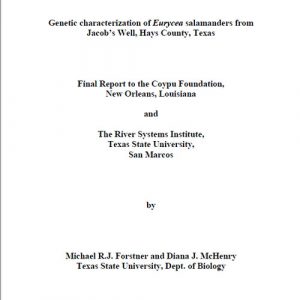Genetic characterization of Eurycea salamanders from Jacob’s Well, Hays County, Texas

The geology of central Texas is dominated by its karst topography. As the limestone has dissolved, the subterranean habitats, and springs that provide the habitats for these salamanders, have become available. The region is characterized by historically abundant surface springs, large cave systems, and dramatic rainfall events. With increased urbanization, surface water impoundment, and ground-water withdrawals, the original ecosystem structure for these salamanders has been altered significantly in the last century. Today, only the largest springs maintain outflows and many of those sites are potentially at risk from ongoing development or other anthropogenic impacts.
One well known site is Jacob’s Well outside of Wimberley, Texas. This site is noted as the longest underwater cave in Texas and for its consistent outflow from the aquifer. It represents one of the primary inflows supporting the Blanco River and continued to flow throughout the drought of record during the 1950s. The spring has stopped flowing twice in recent times; the first was in 2000 and second in 2008. The site has recently been documented to contain Eurycea.
The purpose of this study was to characterize the mtDNA variation for salamanders collected from Jacob’s Well by Zara Environmental, Inc.